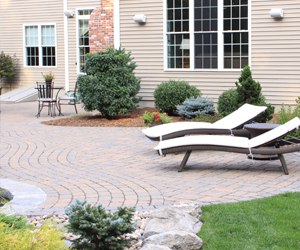The most common question we get asked when considering a paver project is, “How much does it cost per square foot to install pavers?” Unfortunately, there is no simple answer.
Sure, we can do calculations all day long to figure out that last week we installed a 430 sf patio for Mrs. Jones for $9,245.00, and with some quick math, we know that it was installed for $21.50 per square foot. But what about next door? We installed a walkway last week for the Smiths and the price per square foot was closer to $28.00.
What gives? Why did the Smiths have to pay so much more? And what goes into the pricing for each job?
Want to see more about the differences in costs for your landscaping or paver project? Check out our contractor comparison worksheet to see if your potential contractor offers everything you need:

Here’s the catch… no one prices strictly by the square foot anymore – or at least, no one should be. It doesn't make good business sense to price that way, because a variety of other factors need to be considered. All industry leaders say that the best practice is to price out each job individually and to not lump every job into a general price bracket. Put simply, it's because every job is different.
Makes sense, right? Well let’s take a look.

Mrs. Jones’s patio was in the back yard. It was fairly accessible for our trucks and machinery to get in and move around. The soils had decent drainage and stability. There was nothing there that needed to come out first – other than grass and dirt. The paver that Mrs. Jones chose was a traditional 4 by 8 brick shape that she wanted laid in a herringbone pattern.
Next door, the Smiths had just installed a new driveway, and the walkway we were installing connected it to the front door. We couldn’t drive on the new asphalt, so we came in from the road across the front yard. The Smiths also had their septic tank and leach fields in the front yard, so we couldn’t bring our truck in. Everything had to be moved in or out of the walkway area by skid steer or wheel barrow in order to install the pavers. The soil conditions here were the same as at the Jones house, and we laid the same paver in a running bond pattern.
So what different factors were important to each project? Here's what makes the most significant differences in price:
- Project Type - Is it a large area where we can be very efficient with our materials and crews or is it a smaller project with a lot of intricate detail?
- Existing Conditions/Structures - Is there concrete or shrubs to remove? Is there any modification to an existing structure needed?
- Soil Conditions - Are we digging into clay soils or are they well-draining?
- Excavation Depth - Is the project a driveway or a walkway?
- Site Access - Can we easily move in and out of the project area with a truck or other machines?
- Site Dump - Can we leave excavated materials on site or does it need to be hauled away?
- Paver Choice and Pattern - Were basic pavers and patterns chosen or did the customer choose an upgraded paver with a more complex pattern?
Since the work site at the Smith's house was less accessible than at Mrs. Jones's, we had to take a lot longer to move materials. That, along with a difference in installation pattern contributed to the differences in cost.
Want to know more about what else can contribute to a difference in cost for your project? Check out our contractor comparison worksheet to see if your potential landscaper measures up:

Related Articles:
How Much Does a Paver Patio Cost
Comparing Bids Between Landscape Contractors
Quality Workmanship for a Paver Patio; Is it Worth the Price?
Editor's Note: This article was originally posted on 12/06/11, and was updated on 1/31/18.